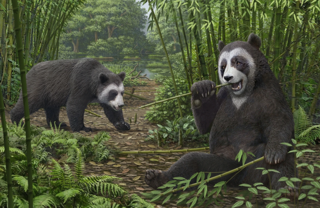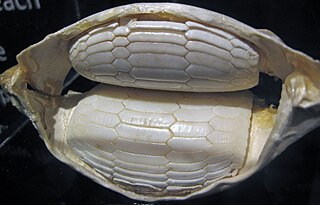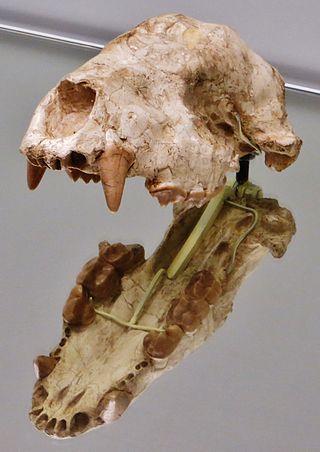
Bears are carnivoran mammals of the family Ursidae. They are classified as caniforms, or doglike carnivorans. Although only eight species of bears are extant, they are widespread, appearing in a wide variety of habitats throughout most of the Northern Hemisphere and partially in the Southern Hemisphere. Bears are found on the continents of North America, South America, and Eurasia. Common characteristics of modern bears include large bodies with stocky legs, long snouts, small rounded ears, shaggy hair, plantigrade paws with five nonretractile claws, and short tails.

Caniformia is a suborder within the order Carnivora consisting of "dog-like" carnivorans. They include dogs, bears, raccoons, and mustelids. The Pinnipedia are also assigned to this group. The center of diversification for the Caniformia is North America and northern Eurasia. Caniformia stands in contrast to the other suborder of Carnivora, the Feliformia, the center of diversification of which was in Africa and southern Asia.

Ailuridae is a family in the mammal order Carnivora. The family consists of the red panda and its extinct relatives.

Gigantopithecus is an extinct genus of ape that lived in southern China from 2 million to approximately 300-200,000 years ago during the Early to Middle Pleistocene, represented by one species, Gigantopithecus blacki. Potential identifications have also been made in Thailand, Vietnam, and Indonesia. The first remains of Gigantopithecus, two third molar teeth, were identified in a drugstore by anthropologist Ralph von Koenigswald in 1935, who subsequently described the ape. In 1956, the first mandible and more than 1,000 teeth were found in Liucheng, and numerous more remains have since been found in at least 16 sites. Only teeth and four mandibles are known currently, and other skeletal elements were likely consumed by porcupines before they could fossilise. Gigantopithecus was once argued to be a hominin, a member of the human line, but it is now thought to be closely allied with orangutans, classified in the subfamily Ponginae.

Ailuropodinae is a subfamily of Ursidae that contains only one extant species, the giant panda of China. The fossil record of this group has shown that various species of pandas were more widespread across the Holarctic, with species found in places such as Europe, much of Asia and even North America. The earliest pandas were not unlike other modern bear species in that they had an omnivorous diet but by around 2.4 million years ago, pandas have evolved to be more herbivorous.

Ailurarctos is an extinct genus of panda from the Late Miocene of China, some 8 million years ago.

Durophagy is the eating behavior of animals that consume hard-shelled or exoskeleton bearing organisms, such as corals, shelled mollusks, or crabs. It is mostly used to describe fish, but is also used when describing reptiles, including fossil turtles, placodonts and invertebrates, as well as "bone-crushing" mammalian carnivores such as hyenas. Durophagy requires special adaptions, such as blunt, strong teeth and a heavy jaw. Bite force is necessary to overcome the physical constraints of consuming more durable prey and gain a competitive advantage over other organisms by gaining access to more diverse or exclusive food resources earlier in life. Those with greater bite forces require less time to consume certain prey items as a greater bite force can increase the net rate of energy intake when foraging and enhance fitness in durophagous species.

Hemicyoninae is an extinct subfamily of Ursidae, often called dog bears. They were bear-like carnivorans living in Europe, North America, Africa and Asia during the Oligocene through Miocene epochs 33.9–5.3 Ma, existing for approximately 28.6 million years. They are sometimes classified as a separate family.

Indarctos is an extinct genus of bear, endemic to North America, Europe and Asia during the Miocene. It was present from ~11.1 to 5.3 Ma, existing for approximately 6.2 million years.

Arctotherium is an extinct genus of the Pleistocene short-faced bears endemic to Central and South America. Arctotherium migrated from North America to South America during the Great American Interchange, following the formation of the Isthmus of Panama during the late Pliocene. The genus consists of one early giant form, A. angustidens, and several succeeding smaller species, which were within the size range of modern bears. Arctotherium was adapted to open and mixed habitat. They are genetically closer to the spectacled bear, than to Arctodus of North America, implying the two extinct forms evolved large size in a convergent manner.

Miklós Kretzoi was a Hungarian geologist, paleontologist and paleoanthropologist and Széchenyi Prize winner.

Agriotheriini is an extinct tribe of ailuropodine bears from the Middle Neogene to Early Quaternary periods with fossils found from Eurasia, Africa and North America. The tribe consists of the genera Agriotherium, Huracan, Indarctos, and possibly Miomaci. The taxonomy of these bears has variously placed some of the genera in other bear lineages such as Hemicyoninae and Ursavinae.

Magericyon is an extinct genus of Amphicyonid ("bear-dog") that lived during the Miocene 10-9 Ma in what is now Spain.

Agriarctos is an extinct genus of panda from the Middle to Late Miocene, approximately 8-18 million years ago. This genus and its type species A. gaali was established based on fossils from Hatvan, Hungary, and A. vighi based on fossils from Rózsaszentmárton. Miklós Kretzoi proposed Agriarctos was closely related with Agriotherium. Previously published, Ursavus depereti was assigned to Agriarctos by Kretzoi, but now proved to be polyphyletic.
Ammitocyon is a genus of large sized carnivoran mammals, belonging to the Amphicyonidae, that lived during the Late Miocene in what is now Spain. It is notable for its extreme adaptations towards hypercarnivory, its extremely robust skeleton, and was one of the last surviving members of its family.
Asilifelis is an extinct genus of small felid that lived in what is now Kenya during the Early Miocene. Despite its fragmentary remains, it is remarkable because of its small size and advanced dentition. It contains a single species, Asilifelis cotae.
Namafelis is an extinct genus of felids that lived in what is now Namibia during the Early Miocene. It contains a single species, Namafelis minor. Closely related to Diamantofelis, it is of “Pseudaelurus-grade”, and therefore a rather basal member of the cat family.
Aurorarctos is an extinct North American genus of bears. It contains a single species, Aurorarctos tirawa, which lived in the Middle Miocene. Its fossils were discovered in the Valentine formation and Myers Farm of Nebraska, and represent the earliest known member of the Ursinae, showcasing that basal members of this subfamily were small, but already showed adaptions towards increasing herbivory as well as an arboreal lifestyle The genus name combines the Latin words aurora (dawn) and Greek arctos (bear); the specific epithet references the creator god Tirawa in Pawnee mythology.
Huracan is an extinct genus of agriotheriin ailuropodine from the Neogene period. Fossils were found from North America and Eastern Asia. Unlike its modern relative the giant panda, which is a bamboo specialist, Huracan was a hypercarnivorous genus of bear that had adaptations for cursoriality.

Fortunictis is a fossil genus of metailurin machairodontine (saber-toothed) felid containing only one species, Fortunictis acerensis. Both the genus and species were described by paleontologist Joan Pons-Moyà in 1987 based on material from Casa del Acero in Spain, which is dated back to the Upper Miocene.
















